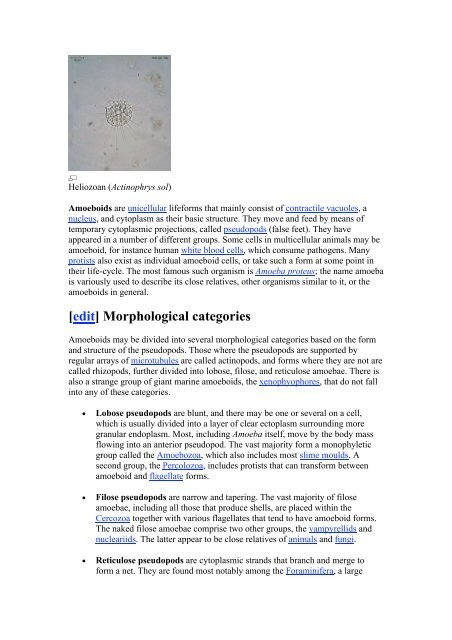Amoeboid - Thierry Karsenti
Amoeboid - Thierry Karsenti
Amoeboid - Thierry Karsenti
You also want an ePaper? Increase the reach of your titles
YUMPU automatically turns print PDFs into web optimized ePapers that Google loves.
Heliozoan (Actinophrys sol)<br />
<strong>Amoeboid</strong>s are unicellular lifeforms that mainly consist of contractile vacuoles, a<br />
nucleus, and cytoplasm as their basic structure. They move and feed by means of<br />
temporary cytoplasmic projections, called pseudopods (false feet). They have<br />
appeared in a number of different groups. Some cells in multicellular animals may be<br />
amoeboid, for instance human white blood cells, which consume pathogens. Many<br />
protists also exist as individual amoeboid cells, or take such a form at some point in<br />
their life-cycle. The most famous such organism is Amoeba proteus; the name amoeba<br />
is variously used to describe its close relatives, other organisms similar to it, or the<br />
amoeboids in general.<br />
[edit] Morphological categories<br />
<strong>Amoeboid</strong>s may be divided into several morphological categories based on the form<br />
and structure of the pseudopods. Those where the pseudopods are supported by<br />
regular arrays of microtubules are called actinopods, and forms where they are not are<br />
called rhizopods, further divided into lobose, filose, and reticulose amoebae. There is<br />
also a strange group of giant marine amoeboids, the xenophyophores, that do not fall<br />
into any of these categories.<br />
• Lobose pseudopods are blunt, and there may be one or several on a cell,<br />
which is usually divided into a layer of clear ectoplasm surrounding more<br />
granular endoplasm. Most, including Amoeba itself, move by the body mass<br />
flowing into an anterior pseudopod. The vast majority form a monophyletic<br />
group called the Amoebozoa, which also includes most slime moulds. A<br />
second group, the Percolozoa, includes protists that can transform between<br />
amoeboid and flagellate forms.<br />
• Filose pseudopods are narrow and tapering. The vast majority of filose<br />
amoebae, including all those that produce shells, are placed within the<br />
Cercozoa together with various flagellates that tend to have amoeboid forms.<br />
The naked filose amoebae comprise two other groups, the vampyrellids and<br />
nucleariids. The latter appear to be close relatives of animals and fungi.<br />
• Reticulose pseudopods are cytoplasmic strands that branch and merge to<br />
form a net. They are found most notably among the Foraminifera, a large


